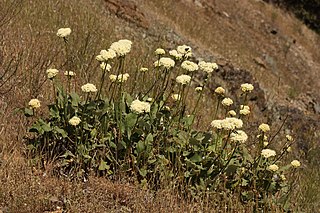
Eriogonum is a genus of flowering plants in the family Polygonaceae. The genus is found in North America and is known as wild buckwheat. This is a highly species-rich genus, and indications are that active speciation is continuing. It includes some common wildflowers such as the California buckwheat.

Eriogonum nudum is a perennial shrub of the wild buckwheat genus which is known by the common name naked buckwheat or nude buckwheat.

Eriogonum fasciculatum is a species of wild buckwheat known by the common names California buckwheat and flat-topped buckwheat. This plant is a widespread and variable shrub of great benefit across its various habitats, providing an important food resource for a diversity of insect and mammal species. It also provides numerous ecosystem services for humans, including erosion control, post-fire mitigation, increases in crop yields when planted in hedgerows, and high habitat restoration value.
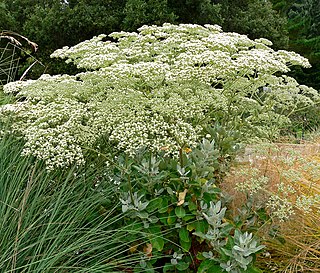
Eriogonum giganteum, with the common name St. Catherine's lace, is a species of wild buckwheat in Southern California.

Eriogonum gracilipes is a species of wild buckwheat known by the common name White Mountains buckwheat.

Eriogonum gracillimum is a species of wild buckwheat known by the common name rose and white buckwheat. It is endemic to California but is common and widespread in many areas there. This is a spindly annual herb reaching anywhere from 5 to 50 centimeters in height. Most of the leaves are basal with a few scattered on the thin branched stem and are generally one to four centimeters long and somewhat woolly, with edges rolled under. Along the thread-thin branches of the stem appear small clusters of flowers which hang on short stalks in bell-shaped involucres. The two-millimeter-wide flowers are bright rose and white in color.

Eriogonum hirtellum is a species of wild buckwheat known by the common name Klamath Mountain buckwheat. It is endemic to the Klamath Mountains of far northern California, where it is known from only a few occurrences.

Eriogonum libertini is a species of wild buckwheat known by the common name Dubakella Mountain buckwheat. This uncommon plant is endemic to California where it grows in the rocky serpentine terrain of the southern Klamath Mountains and nearby ranges.

Eriogonum nidularium is a species of wild buckwheat known by the common name birdnest buckwheat. It is native to the sandy flats and desert dry washes of the Mojave Desert and Great Basin in the western United States, where it is common and abundant. This is a distinctive annual herb producing a thin, multibranched stem which curves in on itself to form a rounded, tangled mass.

Eriogonum reniforme is a species of wild buckwheat known by the common name kidney-leaf buckwheat. It is native to the desert southwest of the United States in California, Arizona, and Nevada, and its range may extend into Mexico.

Eriogonum rosense is a species of wild buckwheat known by the common name rosy buckwheat. It is native to the mountains of eastern California and its range extends into Nevada.
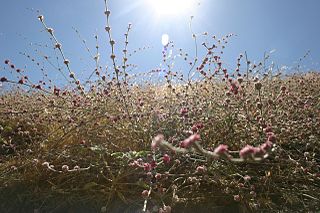
Eriogonum roseum is a species of wild buckwheat known by the common name wand buckwheat. It is native to much of western California and the Sierra Nevada foothills, as well as parts of Oregon, and it is widespread and common in several plant communities.

Eriogonum umbellatum is a species of wild buckwheat known by the common name sulphurflower buckwheat, or simply sulphur flower. It is native to western North America from California to Colorado to central Canada, where it is abundant and found in many habitats, including the sagebrush steppe and alpine areas. It is an extremely variable plant and hard to identify because individuals can look very different from one another. Also, there are many varieties. It may be a perennial herb blooming by summer with stems 10 centimeters tall and two to six clusters of flowers, with a whorl of leaves below the stems, or a sprawling shrub approaching two meters high and wide. The leaves are usually woolly and low on the plant, and the flowers come in many colors from white to bright yellow to purple. Native American groups utilized parts of this plant for a number of medicinal uses.
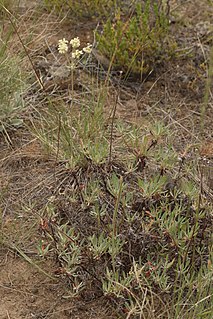
Eriogonum heracleoides is a plant of western North America that has many flowering clusters which are usually cream colored, or off-white. It can usually be found in rocky areas, such as sagebrush deserts and Ponderosa pine forests. Parsnipflower buckwheat is in the genus Eriogonum and the family Polygonaceae, which is a family of plants known as the "knotweed family". It inhabits much of the western part of the United States and southern British Columbia.

Eriogonum luteolum is a species of wild buckwheat known by the common name goldencarpet buckwheat. It is native to many of the mountain ranges of California and southern Oregon, including the Sierra Nevada, Cascades and California Coast Ranges. It grows in mountain and foothill habitat, such as forest and woodland, on granite and sometimes serpentine soils.

Eriogonum siskiyouense is a rare species of wild buckwheat known by the common name Siskiyou buckwheat.

Eriogonum sphaerocephalum is a species of wild buckwheat known by the common names rock buckwheat and round-headed desert buckwheat. It is native to the western United States.

Eriogonum tripodum is a rare species of wild buckwheat known by the common name tripod duckwheat. It is endemic to California, where it is known from the Sierra Nevada foothills and northern sections of the Coast Ranges.

Eriogonum callistum is a rare species of wild buckwheat, known by the common name Tehachapi buckwheat.
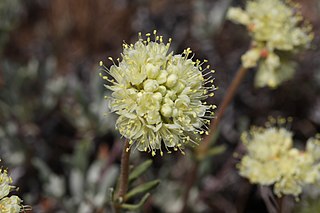
Eriogonum douglasii is a species of wild buckwheat known by the common name Douglas' buckwheat. It is native to the western United States, including the Pacific Northwest and part of the Great Basin.




















